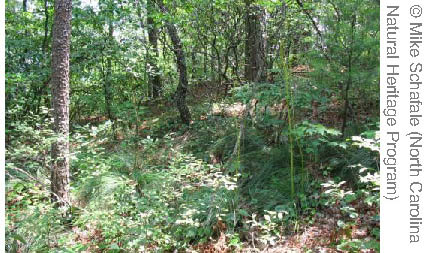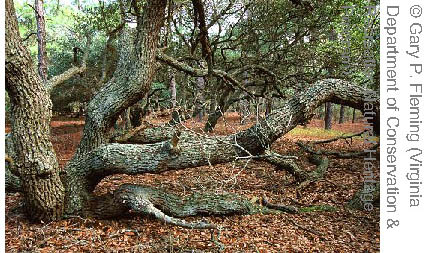The Southern oak-pine macrogroup consists of the following habitats:
Southern Appalachian Low Elevation Pine Forest


Regional distribution:
VA, WV. 22,261 total acres of habitat, of which 7.1% is conserved.
Description:
An open forest or woodland of acidic substrates at low elevations in southwest Virginia. Vegetation is dominated by Virginia and shortleaf pine; occasionally with pitch pine. Hardwoods may be abundant, especially dry-site oaks such as southern red oak, chestnut oak, and scarlet oak, but also pignut hickory, red maple, and others. A heath shrub layer may be well developed. Herbs are usually sparse, though communities of this system may have been grassy when fires were more frequent. The ecological character and natural distribution of this system has been obscured over the years by human settlement, universal logging, pine beetle outbreaks, and fire suppression. Pine-dominated forests have been both created and destroyed in different places by these disturbances.
Download the
pdf for this habitat for information about species, crosswalks to state names, and condition of this habitat.
Central Atlantic Coastal Plain Maritime Forest


Regional distribution:
VA. 6,295 total acres of habitat, of which 88.7% is conserved.
Description:
A mosaic of forests and shrublands of Atlantic Coast barrier islands and similar coastal strands, from Virginia Beach to central South Carolina. Seldom more than 2 miles from the ocean, areas are influenced by salt spray, extreme disturbance events, and the distinctive climate of the immediate coast. Salt-tolerant evergreen tree species are most common, particularly live oak, wax-myrtle, and loblolly pine. Also included are embedded freshwater depressional wetlands dominated by shrubs or small trees, such as red maple, swamp tupelo, stiff dogwood, or swamp bay. The ocean's moderation of climate may be a significant factor in the character of this system; a number of plant species extend much farther north in the maritime forests than they do even a few miles inland.
Download the
pdf for this habitat for information about species, crosswalks to state names, and condition of this habitat.